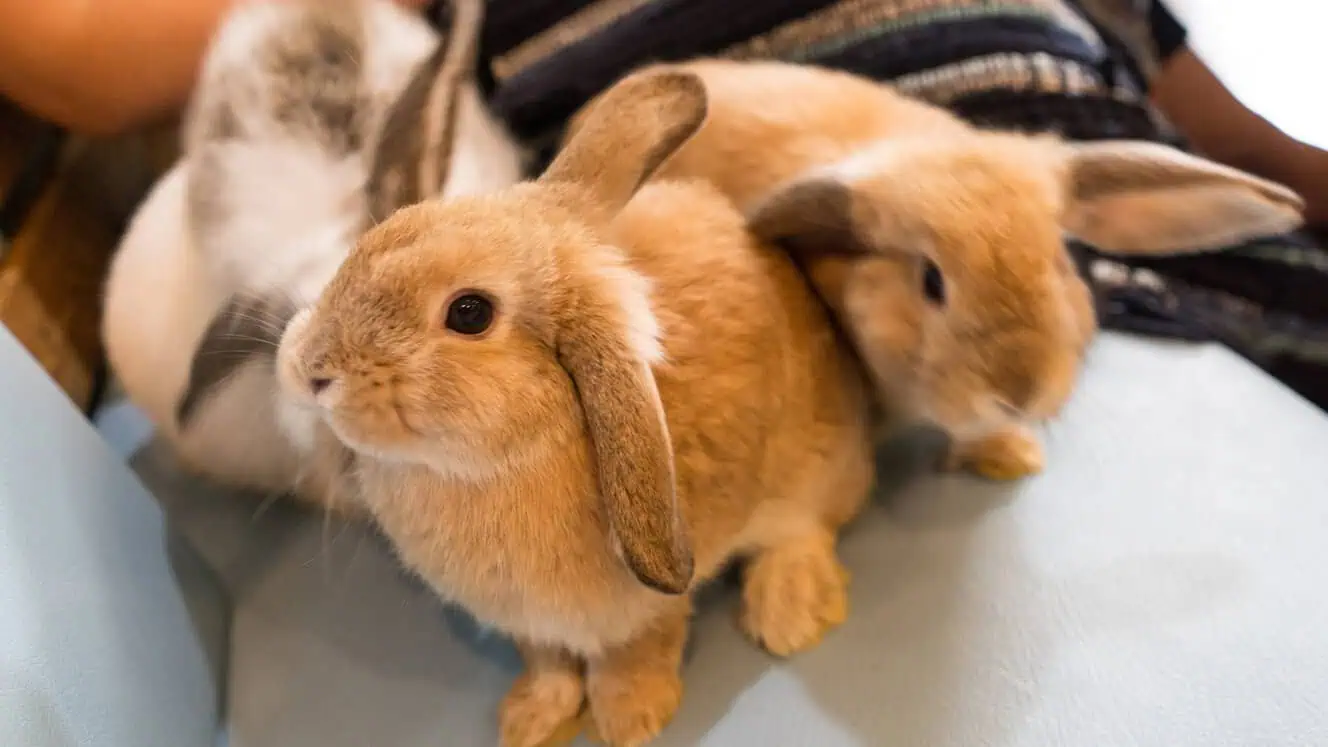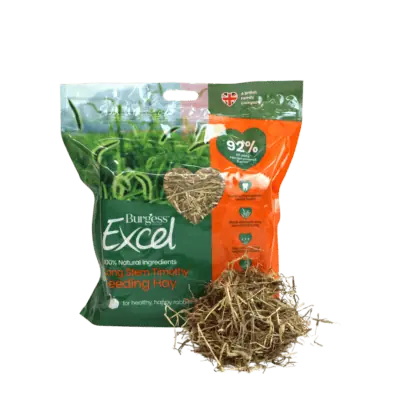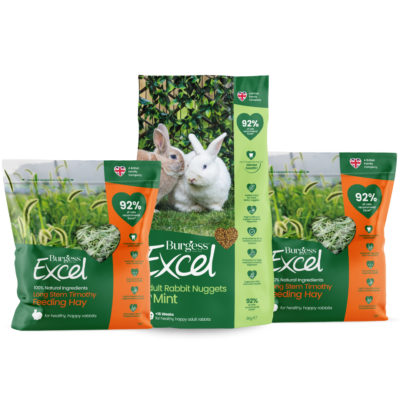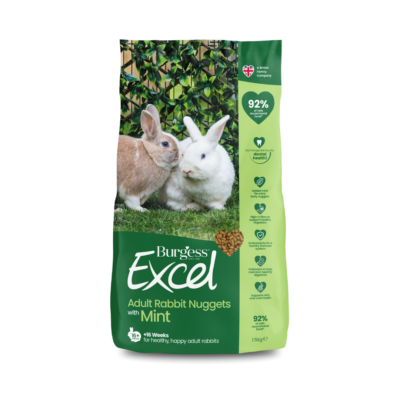
1. WE WANT A SAFE, SPACIOUS HOME WHERE WE CAN GO WHERE WE LIKE, WHEN WE LIKE
Energetic, agile rabbits are made to move – whether that’s hopping to a high spot to scan for danger, running (at up to 35 mph) across an open field and swerving safely away from predators, bolting down tunnels or expertly weaving through dense foliage to find a secluded hiding place.
That’s why our pet rabbits need lots and lots of space – being cooped up in a traditional hutch just doesn’t cut it when it comes to providing a suitable place to live.
Much more appropriate is a converted garden shed, which you can line with plywood and add a range of shelves with steps, along with designated sleeping, eating and toileting areas to make the most of the available space. This will give your buns lots of different areas to hang out in. Indoor rabbits need a large indoor pen or a ‘rabbit-proofed’ room in your home.
And, while a cosy shed will protect outdoor rabbits from the elements (wild rabbits head to their underground warrens when it’s wet and cold), pet buns also need access to outside space. However, letting them out for a run round the garden when it suits you may not match your rabbits’ body clocks and instincts.
Bunnies are crepuscular, which means they like to be out and about in the fresh air in the early morning and early evening. The best way to enable your pet buns to come and go as they please is to have an exercise run permanently attached to their main accommodation.
2. WE’RE SMART AND WE WANT LOTS OF THINGS TO DO SO WE DON’T GET BORED
Rabbits are active, curious creatures who like to spend their time foraging, exploring, playing and checking stuff out.
Whether outdoor or indoor, all pet bunnies need tunnels to run through, look-out spots to keep watch from, low wicker fences to hop over, safe hiding places to escape to (such as cardboard boxes with entrance and exit holes cut out) and cosy sleeping spaces. You can make nap time extra cosy by providing deep piles of sweet-smelling meadow hay and soft, paper bedding, designed especially for rabbits.
Toys can provide hours of entertainment for inquisitive, intelligent bunnies – from cardboard tubes stuffed with feeding hay to munch on, to seagrass balls to bat about and gnaw on. You could also fill wooden foraging puzzles with healthy bunny snacks such as Herby Hearts, Fruity Feasts or Wildflower Forage and watch your buns enjoy figuring out how to get to their tasty treats.
Or why not make some enrichment items yourself? For example, a homemade forage weave encourages stretching and reaching, which is good for your bunnies’ backs. Simply weave some twigs (such as apple, pear, willow, hazel or hawthorn) together and secure them with twine. Then weave in some fresh forage such as sticky weed, rose or wild dog rose, bramble, hazel and buddleia.
In fact, with a little imagination, there are lots of creative DIY ideas you can try which will spruce up your buns’ accommodation and brighten up their day – such as upcycling an old magazine rack and turning it into a hay feeder, or transforming an old bookshelf into a bunny castle. Different rabbits enjoy different types of toys, so provide a variety of items until you find out which ones your rabbits like best.
Some rabbits will enjoy playing games with you – particularly if there are some tasty treats involved! In fact, playing games with your buns is a great way to prevent boredom, encourage exercise and get to understand rabbit behaviour a whole lot better.
3. WE LIKE THINGS CLEAN AND TIDY AND WE WANT ALL OUR STUFF IN PLACES THAT SUIT US
Colonies of wild rabbits live in underground warrens, which consist of private and communal living spaces linked by underground tunnels. These vary in size, with one study finding a 5-year-old rabbit warren that had 150 entrances and had an incredible 517 metres of tunnels!
Unsurprisingly, our pet rabbits also like to have a choice of communal places to hang out together, plus some more private areas to enjoy some ‘me time’, so aim to create a selection of spaces within their accommodation.
For happy bunny days, ensure that there are plenty of resources and toys to go round too. Every rabbit is unique with their own personality, likes and dislikes – and they can be quite protective over favourite toys and places to forage, snooze and play. Disputes over what belongs to who and who’s hanging out where can cause a scuffle between the closest bunny pals!
Rabbits are also very clean animals, so it’s essential that their sleeping areas, feeding spots and toilet facilities are in separate places and their accommodation is kept clean and dry. Do a quick spot check every day, throwing away wet or dirty materials and uneaten food. Each week, remove and replace all their litter and bedding materials. Once a month, give your rabbits’ enclosure a really thorough, deep clean. As rabbits scent mark their stuff, remember to put a little of the old bedding back after a clean so their home smells familiar and reassuring.
4. WE’RE SOCIAL ANIMALS AND NEED COMPANY OF OUR OWN KIND
It’s no surprise that rabbits who bond with their owners live longer and happier lives. Did you know that two bonded rabbits will groom each other, so if you get a lick from your bun, it’s their way of saying: ‘I do like you’, showing that you have been fully accepted as a great bunny owner.
However, for most pet rabbits, life without a bunny chum can be rather lonely. Rabbits are highly social creatures who, in the wild, live in colonies of between 10 and 50 bunnies. This means it’s in their nature to live together in pairs or small groups. Littermates usually make the best companions – but they should always be neutered. If you decide to introduce a new rabbit to your existing bun, this has to be handled very carefully!
A good option is to adopt a new bunny chum from a rescue organisation – the expert staff will go out of their way to match your bun with just the right rabbit friend – and provide you with lots of advice and support on getting them together.
5. SOME THINGS WE LIKE TO DO MAY SEEM STRANGE TO YOU, BUT THEY’RE IMPORTANT TO US
Some rabbit habits can be tricky for humans to understand, while others make much more sense.
For example, many rabbits like to dig, which isn’t really surprising as pet bunnies are related to the wild European rabbit whose scientific name is Oryctolagus cuniculus, which means ‘hare-like digger of underground passages’.
However, if you don’t want your buns tunnelling their way through your flower beds into next door’s garden, (or shredding your carpet if you have indoor buns) and you can’t provide them with their own, supervised digging area or converted sand pit, you’ll need to provide them with some form of digging box.
For an easy-to-make DIY digging and burrowing box that’s suitable for both outdoor and indoor rabbits, Rowan Veterinary Centre suggests you’ll need:
- A large cardboard storage box, or a wooden crate (big enough for your bunny to hop in comfortably)
- Smaller cardboard boxes (enough to fill most of the storage box)
- Newspaper (shredded or crumpled)
- Lots and lots of hay!
- Treats (optional, but highly recommended!)
To create the digging box, simply:
- Cut out an entrance on one side of the large box or crate and place the smaller cardboard boxes inside, cutting some of these into squares or strips, and scrunch up some newspaper and add this in.
- Fill the box with a generous amount of hay, which provides excellent digging material and can become a tasty snack during their burrowing adventures!
- Hide some treats throughout the box to encourage your bunny to explore their new digging paradise. This adds an extra element of fun and positive reinforcement.
Another bunny peculiarity that may be beyond human comprehension is that they like to poo and chew – so a hay rack placed next to their litter tray will be much appreciated. Buns also eat some of their own poo. Called caecotrophy, this enables rabbits to reingest important nutrients – so now you know!
6. WE NEED TO EAT THE RIGHT FOOD
A healthy diet means happy bunnies, which means understanding a bit about rabbit nutrition and what foods they need to eat to thrive.
First off, rabbits must keep their digestive systems busy with a mix of two kinds of fibre – digestible fibre and indigestible fibre – moving through the gut at all times. They get this fibre mainly from good quality feeding hay. Importantly, without high fibre foods, a rabbit’s digestive system will not work correctly, and they will become ill.
That’s why, the main part of a rabbit’s diet – around 85-90% – should be high quality feeding hay. That’s a least their own body size in fresh feeding hay every day. As well as being vital for a healthy digestion, munching on hay also keeps continuously growing rabbit teeth in check, helping to prevent dental disease.
Pet rabbits also need a small portion of high fibre grass-based nuggets (around an egg-cup size a day, per rabbit) which have been specifically formulated to ensure they get all the vitamins and minerals they need for healthy eyes, skin and coats. AVOID colourful muesli-style mixes as these encourage selective feeding, where rabbits eat some (high starch/sugar) components, while rejecting the more fibrous pellets, resulting in all sorts of health problems.
A small handful of fresh greens daily, such as broccoli, fennel, parsley, basil, dandelion leaves and rocket should also be on the menu. And don’t forget a few nutritious snacks. After all, every bunny deserves a treat, as long as it’s a healthy one! Yummy, healthy rabbit treats add enrichment to your pets’ day and are great for training and hand feeding, helping you to build your bond with your bunny chums.
Remember to provide plenty of fresh water too. Bowls are better than bottles as lapping from a bowl is more natural to rabbits. However, as bowls may get knocked over, it’s a good idea to provide a sipper bottle too. Change the water daily and keep water receptables scrupulously clean.
7. WE RELY ON YOU TO CHECK WE ARE HEALTHY AND HAPPY
As prey animals, rabbits will try and hide the fact they’re feeling unwell (as, in the wild, this would make them more vulnerable to predators). So, it’s up to us humans to keep a close eye and ensure they’re healthy and thriving. Top tip – it’s best to avoid picking rabbits up as they tend to prefer being groomed, checked over and petted on the floor where they feel safer.
From neutering to vaccinations and regular check-ups at the vets, to grooming and good housekeeping, as well providing the very best in bunny nutrition, humans play a vital role in keeping their rabbit pals happy and healthy.
8. WE APPRECIATE IT WHEN YOU TRY TO UNDERSTAND US
Spending quality time with your buns every day helps you keep a close eye on how they’re doing and will enable you to build a very special bond with these fabulous small furries.
You’ll also start to learn more about these often-misunderstood animals, which will be an incredibly rewarding experience for both you and your bunny buddies.
Who knows, after a while, you might be able to actually speak a little rabbit yourself and understand what all that chin rubbing, nose nudging, tail wagging, binkying and chucking stuff about actually means!
LOVE YOUR BUNS? Did you know that in 2006, Burgess Pet Care launched the first Rabbit Awareness Week (RAW). Collaborating with leading animal charities and vet bodies, this annual campaign serves to educate rabbit owners about the best ways to care for their pets and continually improve rabbit welfare. Sign up to be the first in the know about Rabbit Awareness Week 2025! >>
TOP TIP! Traditionally thought of as good pets for children, rabbits are not easy to look after correctly. Small animals are often more complex to feed and care for than a cat or dog and require more looking after than a child can offer. So, while it’s lovely for children to enjoy the company of rabbits, the responsibility for any animal’s wellbeing lies with adults, who must always be responsible for overseeing their care.
NUTRITIOUS FOOD FOR HEALTHY, HAPPY RABBITS – 92% OF UK VETS RECOMMEND OUR BURGESS EXCEL SMALL PETS RANGE!
Rabbits are herbivores and need a plant-based diet with lots of fibre to keep their digestive system healthy. Along with their rabbit nuggets and a few healthy treats make sure your rabbits have unlimited access to good quality, dust extracted feeding hay and fresh grass (but not grass cuttings) to graze on.
Check out our tasty nugget varieties specially created for junior and dwarf rabbits, indoor bunnies, golden oldies, adult rabbits – there’s even a light recipe for buns who are watching their weight!
Are your bunnies Burgess bunnies? Join the Burgess Pet Club for exclusive offers and rewards.
12 fascinating facts you may not know about Burgess Pet Care! >>
KNOW YOUR BUNS! Find out all you need to know about caring for your bunny chums with this COMPREHENSIVE RABBIT CARE GUIDE >>
LET’S GET SOCIAL! Sign up to the Excel Bunny Base – a safe Facebook community for rabbit guardians that are looking for advice and friendly discussions from likeminded owners – and there are lots of cute bunny photos and videos! Also join us on Instagram.
If you found this interesting, you may also like:
21 AMAZING RABBIT FACTS FOR BUNNY FANATICS Even if you’re a lifelong bunny lover, there are a few things you may not know about your hay-chomping chums.
DO YOUR SMALL PETS HAVE THE RIGHT TO ROAM? Find out why giving small furries the chance to scamper about in a safe, enriching space is essential to their health and wellbeing.
WHAT PUTS YOUR SMALL PETS IN A GOOD MOOD? Along with socialising with their same species companion and interacting with their favourite human, our survey reveals the best thing you can to do to give your small furries a happiness boost…
SPRING DAYS IN THE SUNSHINE Just like us, our rabbits and guinea pigs are eager for some fresh spring air. However, if you’ve decided it’s time to let your small pets enjoy some outdoor time, there are precautions you need to take so it’s not a shock to their system.
HOW MUCH SPACE DO YOUR RABBITS NEED? If you have a couple, a throuple or even a band of well-bonded bunnies, you’ll know just how much they love hanging out together. However, even the best bunny pals need their own space.
HOW TO HELP YOUR BUNNIES GET ALL THE EXERCISE THEY NEED To encourage your bunny chums to like to move it, move it, create an exciting space where they can hop, run, jump, explore and forage.
LITTER TRAINING YOUR RABBITS Whether your buns live indoors or out, litter training has lots of benefits – both for them and you!
HOW DO YOU GROOM RABBITS? Keeping clean and neat is very important to rabbits and, just like cats, buns spend a huge amount of time grooming themselves. They also need a little help from us.
WHICH POPULAR RABBIT BREEDS HAVE THE MOST HEALTH ISSUES? ‘Cute’ bunny breeds such as the Lionhead rabbit, the Netherland Dwarf rabbit and the Mini Lop, are at risk from long-term health problems.
INDOOR GUINEA PIGS AND HOUSE BUNNIES Once traditionally always housed outdoors, many people enjoy keeping their guinea pigs or rabbits as indoor pets – and there are all sorts of reasons why.
BONDING WITH YOUR BUNNY CHUMS Whether your buns are already part of the family, or you’ve just welcomed some new rabbits into your family, find out how to deepen your connection with your nose-twitching pals.
WHAT’S IN SEASON? HOW TO CHOOSE SAFE FRESH FOOD FOR YOUR SMALL PETS Select safe fruits, vegetables and leafy greens for your small pets to nibble on – you could even forage for some tasty titbits or grow your own!
RABBITS AND GUINEA PIGS – IS INDOORS OR OUTDOORS BEST? Is the outdoor life better for bunnies and guinea pigs, or will these small pets have a more enriching time if they’re kept indoors?
GAMES TO PLAY WITH YOUR RABBITS Bunnies are smart and active creatures who like lots of things to do and games to play – particularly if there are some tasty rabbit treats involved. We’ve some fun ideas to add interest and excitement to your buns’ day.
BUNNY TALK Rabbits have a complex language all of their own. By learning to understand their body postures, behaviours and vocalisations, you’ll uncover their individual personalities.
HOW TO BE A GOLD-STAR INDOOR BUNNY OWNER Indoor rabbits make fabulous house pets, as long as you provide these smart and sociable animals with everything they need.
HOW TO PROTECT YOUR GUINEAS AND BUNNIES FROM PESKY PARASITES When it comes to protecting our small pets from mites, fleas, flies, ticks and mosquitoes, a four-pronged attack is the best approach.
FINDING A VET FOR YOUR SMALL PETS Did you know that just like hospital specialists, vets have different areas of expertise? That’s why, if you have small pets, it can be a good idea to seek out a vet that specialises in small animal medicine.
SMALL FURRIES NEED A SECOND CHANCE TOO As well as taking on a rescue dog or adopting a cat from an animal sanctuary, did you know that there are lots of small furries in rescue centres around the country that are looking for loving homes?
PET INSURANCE EXPLAINED Can you get pet insurance for pre-existing conditions? Can you get pet insurance for older pets? Can you get multi-pet cover? We answer some of the most commonly asked questions to help you make an informed decision.

















